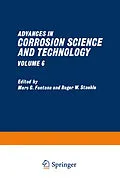This series was organized to provide a forum for review papers in the area of corrosion. The aim of these reviews is to bring certain areas of corrosion science and technology into a sharp focus. The volumes of this series are published approximately on a yearly basis and each contains three to five reviews. The articles in each volume are selected in such a way as to be of interest both to the corrosion scientists and the corrosion technologists. There is, in fact, a particular aim in juxtaposing these interests because of the importance of mutual interaction and interdisciplinarity so important in corrosion studies. It is hoped that the corrosiori scientists in this way may stay abreast of the activities in corrosion technology and vice versa. In this series the term "corrosion" is used in its very broadest sense. It includes, therefore, not only the degradation of metals in aqueous en vironment but also what is commonly referred to as "high-temperature oxidation. " Further, the plan is to be even more general than these topics; the series will include all solids and all environments. Today, engineering solids include not only metals but glasses, ionic solids, polymeric solids, and composites of these. Environments of interest must be extended to liquid metals, a wide variety of gases, nonaqueous electrolytes, and other non aqueous liquids.
Inhalt
1 Protection of Superalloys for Turbine Application.- Protection System Selection.- Service Requirements.- Alloy Substrate.- Protection Systems.- Classification.- Diffusion Coatings.- Overlay Claddings.- Ceramic Barriers.- Processing Techniques.- HIP Cladding.- Hot Dipping.- Hot Metal Spraying.- Slurry Coating.- Electrophoresis.- Electroplating.- Metalliding.- Vapor Deposition.- Sputtering.- Glow Discharge Impregnation.- Pack Cementation.- Pack Coatings: Fundamental Aspects.- Stability of Aluminide Phases.- Identification of Phases.- Mass Transfer in Aluminide Phases.- Vapor Phase Reactions and Processes.- Mechanisms of Coating Formation.- General Comments.- Coating Degradation.- Degradation Mechanisms.- General Comments.- Testing and Inspection.- Coating Performance.- Oxidation Resistance.- Hot Corrosion Resistance.- Mechanical Properties.- Conclusions and Recommendations.- References.- 2 Hydrogen Embrittlement and Stress Corrosion Cracking of Uranium and Uranium Alloys.- Polymorphism in Uranium.- Phase Transformations in Uranium Alloys.- Embrittlement and Cracking Trends.- Systems that Embrittle and/or Stress Corrosion Crack.- Uranium.- Uranium-Titanium Alloys.- Uranium-Molybdenum Alloys.- Uranium-Niobium Alloys.- Uranium-Niobium-Zirconium Alloys.- Polynary Alloys.- Effect of the Environment on Embrittlement and Stress Corrosion Cracking in Uranium and Uranium Alloys.- Gases.- Electrolytes.- Effect of Temperature.- The Effects of Metallurgical Parameters on Embrittlement and Stress Corrosion Cracking.- Heat Treatment.- Cold Work.- Surface Condition.- Grain Size.- Specimen Orientation.- Impurities.- Mechanisms.- Hydride Formation.- Anodic Dissolution.- Oxide Stress Generation.- Protective Coatings.- Oxides.- Organic.- Metallic.- Summary.- References.- 3 The Polarization Resistance Technique for Measuring Corrosion Currents.- Historic Development.- Derivation of Basic Equations.- The Constant in the Equation.- Theoretical Values.- Theoretical Polarization Curves for Different Combinations of Tafel Slopes.- Experimental Determination of the Constant B.- Errors due to Uncertainty of the Value of the Tafel Slopes.- The Question of Linearity.- Limitations and Problems.- Contribution from Additional Redox Reactions.- Effect of Electrolyte Resistance.- Chemical Corrosion.- Experimental Techniques and Instrumentation.- Laboratory Experiments.- Corrosion Rate Meters.- Applications of Polarization Resistance Technique.- Related Techniques.- The Technique of Engell.- The Technique of Barnartt.- Impedance Techniques.- The Method of Oldham and Mansfeld.- The Methods of Mansfeld.- References Related to the Polarization Resistance Technique.- Related References.
